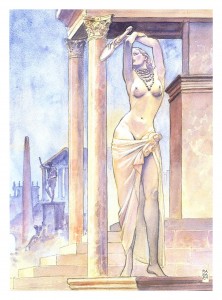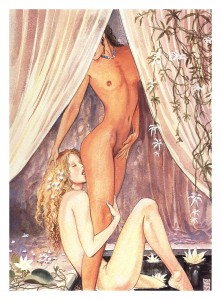A comment on Aphrodite (AKA Ancient Manners) by Pierre Louÿs
The plot revolves around the two main figures, heralds of Eros, the
divine prostitute Chrysys and the gorgeous and distant artist and lover
of the Queen of Alexandria, Demetrios.
The tale is set in a pagan pre-christian classical antiquity, in
which there is no concept of sin and guilt and the forces of Eros are
flowing free. The protecting goddess of Alexandria in this novel is
Aphrodite, the goddess of beauty and love.
Aphrodite’s statue was sculpted by Demetrios himself and it’s figure
it’s based on the Queen’s figure. However, Demetrios when the statue is
completed, loses gradually his attraction to the Queen’s figure and
loves the image of eternal beauty symbolized by the statue.
His Eros, thus, is directed toward the archetype of the feminine beauty
and sensuality, but is incapable of loving it’s manifestation in the
actual woman after a brief moment of infatuation and passion.
On the other hand, Chrysys is the incarnation of pure and wild feminine
Eros: sensual, carefree, both sweet and lethal, she lives the passion of
the total abandon fully; however, her Eros is narcissistic and
fundamentally driven by the lust for power (over her lovers, in various
forms) that her beauty may carry.
Since the two are complementary in their fundamental narcissism a
wild but distorted passion flows between the two; however because of
this the erotic tension never finds a proper release. First, Chrysys,
intoxicated by her lust of power asks Demetrios, who is fully enchanted
by the image of the pure feminine in her, to steal, kill and dishonorate
the statue of the Goddess that he himself has created. He does so, but
as soon he has committed his crime, he has a dream in which he unites
with Chrysys and his Eros, since it’s directed towards the idea of the
woman only, is satisfied and loses interest in her. Meanwhile, Chrysys
lives an episode of ego inflation and basks herself in her false sense
of power. However, as soon she wants to donate herself fully to
Demetrios and falls in love with him, he refuses her. Logically, the
parts are now inverted and now is Chrysys which is intoxicated by the
figure of Demetrios and wants to be his slave. But the fundamental
situation hasn’t changed: Chrysys is in love with her own femininity and
the power that it may carry and Demetrios is in love with the archetype
of the eternal feminine beauty. The two situations are at the very core
not separated (the opposites are only the two faces of a same
phenomenon) and the erotic tension doesn’t find a proper release.
Demetrios in fact asks Chrysys to carry the objects that he has
obtained with crime to the main square of the city, thus sentencing
herself to death. She thinks of not doing it, but at last she falls prey
of her inconscious death drive which was behind her Eros and lives a
last moment of inflation by identifying herself with Aphrodite, the
Goddess that Demetrios loves, and present herself naked, adorned only
with the objects of crime, on the top of a tall tower, a final testament
of the part of eternal beauty and sensuality that she incarnates.
Demetrios visits her in jail, before the execution (suicide by
poison, like Socrates) but he doesn’t lay with her. The erotic tension
doesn’t find a proper release in a real sexual union; in fact he waits
her to be dead to create a new sculpture from the form of her cadaver,
thus immortalizing her beauty.
The most balanced character in the novel is Timon, an intelligent
libertine, which is capable of deep thinking and aestethic sensibility
but also of genuine erotic love (which requires a contact, a genuine
relation with some tension between the two poles of the erotic play) and
is the only male in the novel that manifests some sincere human pietas
towards Aphrodisia (a beautiful slave which ends to be accused on one of
Demetrios’s crimes and crucified just before being liberated) and
Chrysys. He’s the only which maybe is able to experiment and understand
the full spectrum of erotism: intellect but also raw emotions and
sensations; love for beauty but also for the person in which this beauty
manifests itself.
The two main themes of the novel, as it can be easy now to guess, are
the relation between Eros and Thanatos and their fundamental unity
between the swings and the tension in the two and the relationship
between art and life.
The first of these two is also very well portrayed in the picture of
the society of Alexandria, which is capable at the same time of great
erotic abandon and sensuality, with great deals of pleasure and extreme
and brutal cruelties. In fact, the crucifixion of the innocent and
gorgeous Aphrodisia happens during an orgy of sensual pleasure!
This also is reflected in the two main aspects of the festival of the
Goddess: the moment of maximum beauty and pleasure is also the moment in
which Chrysys presents herself naked and sentences herself to her
death.
The eroticism of the novel is very cerebral and erudite, full of
classical references and sensuous poetry and it flows very well, it
isn’t overly cerebral or fake. The novel condemns the thought which
excludes totally the power of the senses: at the orgy the philosophers
(with the exception of Timon) are portrayed as cold over-thinkers,
sophists incapable of finding really the truth or letting themselves go
or relating themselves fully to the others: a philosopher tries to cheer
up Aphrodisia in her final moments by coldly explaining to her the
theory of stoic detachement and indifference, but without really
partecipating to her pain or relating deeply to her in this fatal
moment, while Timon is more mature and is able to relate and feels a
genuine compassion for the innocent crucified victim.
It also present a slight stint towards feminine homosexuality, which
is praised and accepted in the course of the novel, while male
homosexuality isn’t totally approvated by Louys.
The relationship of art and life runs subtly long all the novel, but
it deflagrates in the most dramatic moments, during Aphrodisia and
Chrysys’s deaths, and then it returns in the shadows, but always present
as a costant aesthetic tension, capable of great images of beauty and a
vividly beautiful game of lights and shadows, the eternal tension and
play between the opposites.
Maybe Louys maybe suffered the same problem of Demetrios in his life,
as one of his last poems, composed in late life when he was old and
wretched, testimonies:
“Je mourrai sans autre raison
Que d’avoir revu ma maison
Eventrèe, ainsi qu’une femme,
Tous mes bien volès ou perdus,
Souillés, dispersés ou vendus,
À la fin d’une historie infame!
De tout ce que j’avais amassé
Les bougres ne mont rien lassé.
Je reste assis sur une dalle,
Sur le marche de mon palier,
Sans conservar méme un soulier
Méme un soc, méme un sandale.
Et j’aurais donné la moitié
De ma chair pour une amitié
Bien plus que pour l’amour lui-même.
Je croyais tant au coeur humain,
À la main forte dans la main
Et tant encore je crois qu’on m’aime.”
He lived a great conflict between his tought and his actual life: his
friendships with Gidè and Wilde were stormy and ended in quarrels and
he didn’t have the courage to defend Wilde in the court while he was
being processed for his homosexuality. He surely was an interesting and
lacerated man…
NOTE: The book is available for free in English on Project Gutemberg.

